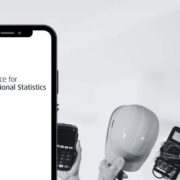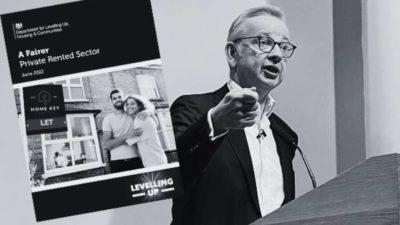The annual percentage change for average UK house prices was 10.3% in the year to November 2022, compared with 12.4% in the year to October 2022 and 9.8% in the year to September 2022.
The average UK house price was £295,000 in November 2022, which is £28,000 higher than this time last year.
Average house prices increased over the year to £315,000 (10.9%) in England, to £220,000 in Wales (10.7%), to £191,000 in Scotland (5.5%) and to £176,000 in Northern Ireland (10.7%).
On a non-seasonally adjusted basis, average UK house prices decreased by 0.3% between October and November 2022, while average UK house prices increased by 1.5% during the same period last year.
House price annual growth was strongest in the North West where prices increased by 13.5% in the year to November 2022.
The lowest annual growth was in Scotland, where prices increased by 5.5% in the year to November 2022.
London was the English region with the lowest annual growth, where prices increased by 6.3% in the year to November 2022.
The Royal Institution of Chartered Surveyors’ (RICS’) November 2022 UK Residential Market Survey reported that overall activity continues to weaken across the sales market, with higher interest rates and a difficult macroeconomic outlook taking their toll on buyer sentiment.
The Bank of England’s Agents summary of business conditions 2022 Q4 reported the supply of homes for sale increased faster than demand with higher borrowing costs and concerns about affordability weighing significantly on demand from first-time buyers.
The UK Property Transactions Statistics showed that in November 2022, on a seasonally adjusted basis, the estimated number of transactions of residential properties with a value of £40,000 or greater was 107,190.
This is 13.3% higher than a year ago (November 2021). Between October and November 2022, UK transactions increased by 0.2% on a seasonally adjusted basis.
The Bank of England’s Money and Credit November 2022 release reported that mortgage approvals for house purchases, an indicator of future borrowing, decreased to 46,100 in November 2022, from 57,900 in October 2022.
This is the lowest level since June 2020 (40,500).
England
In England, the November data shows that, on average, house prices have fallen 0.2% since October 2022. The annual price rise of 10.9% takes the average property value to £315,073.
The regional data for England indicates that:
- the North West experienced the greatest annual price rise, up by 13.5%
- the East of England experienced the greatest monthly growth, with an increase of 0.6%
- London saw the lowest annual price growth, with an increase of 6.3%
- The North East saw the most significant monthly price fall, with a movement of –2.6%
Price change by region for England
| Region | Average price November 2022 | Annual change % since November 2021 | Monthly change % since October 2022 |
|---|---|---|---|
| East Midlands | £253,498 | 12.2 | 0.2 |
| East of England | £365,144 | 10.2 | 0.6 |
| London | £542,311 | 6.3 | 0.1 |
| North East | £162,596 | 11.6 | -2.6 |
| North West | £221,224 | 13.5 | 0.4 |
| South East | £402,466 | 10.0 | -0.5 |
| South West | £337,144 | 11.8 | -0.3 |
| West Midlands | £256,937 | 12.3 | -0.1 |
| Yorkshire and the Humber | £212,329 | 11.4 | -0.7 |
Repossession sales by volume for England
The lowest number of repossession sales in September 2022 was in the East of England.
The highest number of repossession sales in August 2022 was in the South East.
| Repossession sales | September 2022 |
|---|---|
| East Midlands | 7 |
| East of England | 1 |
| London | 8 |
| North East | 7 |
| North West | 16 |
| South East | 17 |
| South West | 2 |
| West Midlands | 9 |
| Yorkshire and the Humber | 14 |
| England | 81 |
Average price by property type for England
| Property type | November 2022 | November 2021 | Difference % |
|---|---|---|---|
| Detached | £495,804 | £447,138 | 10.9 |
| Semi-detached | £302,583 | £270,991 | 11.7 |
| Terraced | £259,045 | £230,447 | 12.4 |
| Flat/maisonette | £254,485 | £238,304 | 6.8 |
| All | £315,073 | £284,149 | 10.9 |
Funding and buyer status for England
| Transaction type | Average price November 2022 | Annual price change % since November 2021 | Monthly price change % since October 2022 |
|---|---|---|---|
| Cash | £294,910 | 10.5 | -0.2 |
| Mortgage | £325,101 | 11 | -0.2 |
| First-time buyer | £261,377 | 11 | -0.2 |
| Former owner occupier | £361,530 | 10.8 | -0.1 |
Building status for England
| Building status | Average price September 2022 | Annual price change % since September 2021 | Monthly price change % since August 2022 |
|---|---|---|---|
| New build | £425,527 | 20.2 | 5.4 |
| Existing resold property | £307,755 | 8.9 | 0.6 |
London
London shows, on average, house prices have risen by 0.1% since October 2022.
An annual price rise of 6.3% takes the average property value to £542,311.
Average price by property type for London
| Property type | November 2022 | November 2021 | Difference % |
|---|---|---|---|
| Detached | £1,113,571 | £1,045,214 | 6.5 |
| Semi-detached | £711,357 | £657,069 | 8.3 |
| Terraced | £601,131 | £551,005 | 9.1 |
| Flat/maisonette | £443,767 | £427,938 | 3.7 |
| All | £542,311 | £510,077 | 6.3 |
Funding and buyer status for London
| Transaction type | Average price November 2022 | Annual price change % since November 2021 | Monthly price change % since October 2022 |
|---|---|---|---|
| Cash | £556,297 | 4.6 | 0.2 |
| Mortgage | £536,895 | 6.7 | 0.1 |
| First-time buyer | £466,460 | 6.1 | -0.1 |
| Former owner occupier | £625,609 | 6.5 | 0.4 |
Building status for London
| Building status | Average price September 2022 | Annual price change % since September 2021 | Monthly price change % since August 2022 |
|---|---|---|---|
| New build | £589,560 | 15 | 4.6 |
| Existing resold property | £543,025 | 6.4 | -0.4 |
Wales
Wales shows, on average, house prices have fallen by 1.6% since October 2022.
An annual price rise of 10.7% takes the average property value to £220,366.
There were 10 repossession sales for Wales in August 2022.
Average price by property type for Wales
| Property type | November 2022 | November 2021 | Difference % |
|---|---|---|---|
| Detached | £336,710 | £307,705 | 9.4 |
| Semi-detached | £214,007 | £193,404 | 10.7 |
| Terraced | £172,992 | £153,113 | 13.0 |
| Flat/maisonette | £136,269 | £128,422 | 6.1 |
| All | £220,366 | £199,006 | 10.7 |
Funding and buyer status for Wales
| Transaction type | Average price November 2022 | Annual price change % since November 2021 | Monthly price change % since October 2022 |
|---|---|---|---|
| Cash | £212,605 | 9.8 | -1.9 |
| Mortgage | £224,829 | 11.1 | -1.5 |
| First-time buyer | £189,969 | 11.2 | -1.5 |
| Former owner occupier | £256,108 | 10.2 | -1.7 |
Building status for Wales
| Building status | Average price September 2022 | Annual price change % since September 2021 | Monthly price change % since August 2022 |
|---|---|---|---|
| New build | £325,064 | 23.6 | 6.3 |
| Existing resold property | £219,352 | 12.9 | 2.2 |
Tom Bill, head of UK residential research at Knight Frank, comments:
“The figures highlight the change that has taken place in the UK property market over recent months.
The experience for people completing their purchase last November contrasts sharply with the reality faced by buyers who are starting their search this month.
Mortgage rates are edging down as the shock of the mini-Budget works its way through the system but are still around 1.5 percentage points higher than last summer.
A new normal is gradually emerging for rates and over the next few months we will get a clearer sense of how people react once they recalculate their budgets.
This decision-making process rather than what happened last year will set the trajectory for the housing market in 2023.”
Jeremy Leaf, north London estate agent and a former RICs residential chairman, comments:
“This most comprehensive of all the housing market surveys always commands attention.
However, the figures mainly reflect what was happening in the quieter period between September’s disastrous mini-Budget and the lead up to Christmas.
On the ground, since our return to work nearly three weeks ago, we have noticed the release of some pent-up demand now mortgage rates have begun to fall.
Activity has been supported by gloomy predictions for prices in the media, which has reduced buyer and seller expectations and resulted in agreed sales at more realistic levels.”
Avinav Nigam, cofounder of real estate investment platform, IMMO, comments:
“This slight fall in house prices was expected, as economic confidence has fallen and interest rates have risen, making purchasing properties more expensive and harder to do.
Buying property is more expensive due to higher rates.
The stress tests applied by banks are also more stringent.
The result is that many who had hoped to purchase using mortgage finance will no longer be able to.
Younger and poorer households are disproportionately affected.
Their need for housing is unchanged, but their ability to access it through home ownership is.
Demand for rental properties continues to grow.
The opportunity for professional providers of safe, quality and affordable rental housing for the UK is increasingly clear.”
Mark Harris, chief executive of mortgage broker SPF Private Clients, comments:
“Inflation dipping for the second month in a row to 10.5 per cent will help ease some pressure on the Bank of England but another increase in base rate next month is still on the cards.
Back in November, both Swaps and fixed-rate mortgages were rather higher than they now, as a result of the fallout of the mini-Budget.
Much of that turmoil has passed through the system now, with Swaps and fixes continuing to fall.
While the days of the sub-1 per cent five-year fix may be long gone, it’s only a matter of time before they edge below 4 per cent as the cost of funds falls, servicing pressures subside and lenders look to originate new business.”
Tomer Aboody, director of property lender MT Finance, comments:
“With sales volumes at virtually 50 per cent of what they were the previous November, it’s no surprise there has been another increase in property values even though the cost of living and interest rates continue to rise.
Pent-up demand and ready buyers are still there to make a move, but lack of stock is keeping market demand high, resulting in an uptick in prices on an annual basis.
Some government intervention is needed in order to increase activity and there would be nothing better than a stamp duty adjustment in order to get people moving.”
Jason Ferrando, CEO of easyMoney, comments:
“Judging the overall health of the UK property market based on the short-term erratic measure of monthly house price growth is ill-advised, to say the least.
Despite November bringing the first actual monthly decline in house prices since October 2021, property values still remain extremely close to their highest point seen throughout the pandemic.
It’s also important to consider the lagged nature of reporting when it comes to house prices and so what this marginal realignment really represents is a housing market winding down as it approaches the end of the year, not one approaching a cliff edge.”
CEO of Alliance Fund, Iain Crawford, comments:
“The current outlook for the housing market is far more positive than it was just a few short months ago and while we continue to tread with some degree of caution, the general consensus is that the year ahead will bring greater stability.
With this in mind, the marginal monthly decline seen between October and November is likely to be short lived and is almost certainly being influenced by the seasonal slowdown approaching the festive season.”
Managing Director of Barrows and Forrester, James Forrester, comments:
“The first monthly reduction in house prices in 13 months is sure to spur panic and predictions of a property market collapse, but to do so based on just one month is quite frankly ludicrous.
The reality is that the property market has well and truly weathered the storm caused by the incompetence of the UK government and remains in fine form despite a very marginal reduction in property values.
If we were going to see a notable dip, it would have materialised by now. This hasn’t been the case and while the heat of the pandemic market boom may have subsided, property prices remain considerably higher than they were this time last year.”
Director of Benham and Reeves, Marc von Grundherr, comments:
“It’s been a swift start to the year and those of us with our ear to the ground will tell you that both buyer and seller enquiries are coming in thick and fast, particularly across the London market.
So while we may have seen a momentary period of respite towards the end of 2022, there is a renewed level of optimism enveloping the market so far this year.
We remain a nation driven by the aspiration of homeownership and it’s only a matter of time before this uplift in activity reverses the reduced rates of house price growth seen during the latter stages of last year.”
Managing Director of House Buyer Bureau, Chris Hodgkinson, comments:
“The current cost of living crisis and the increased cost of borrowing, in particular, have somewhat dampened the enthusiasm of the nation’s homebuyers in recent months and we’re now starting to see this translate to a slight reduction in house prices.
However, the property market landscape is a fragmented one and while many homeowners will have avoided a dip in the value of their property, there are plenty of areas where house prices have started to slide to a far greater extent.
While it’s generally expected that the market will remain resolute this year, sellers in areas where the market is coming off the boil are well advised to sell quickly in order to achieve the best price for their home.”




















Comments